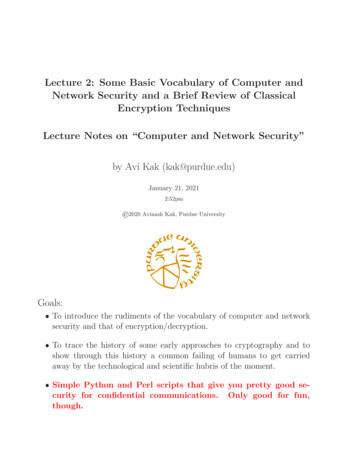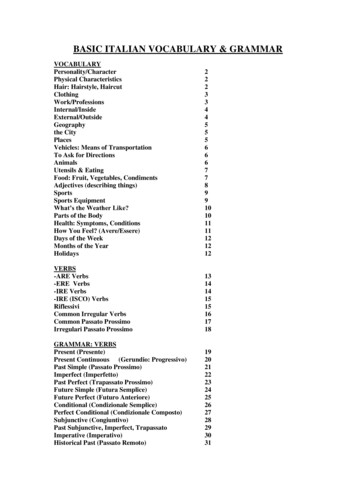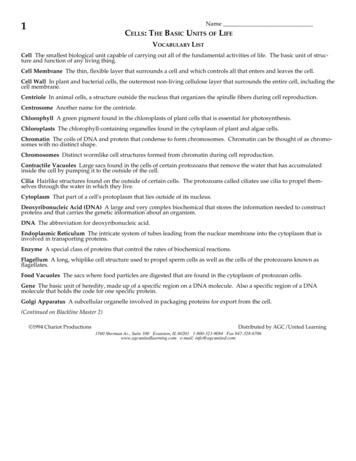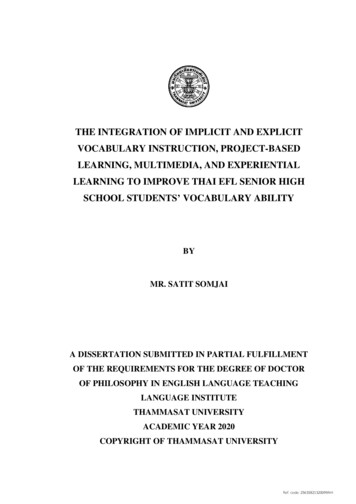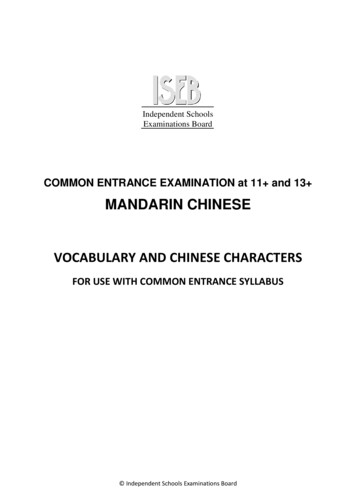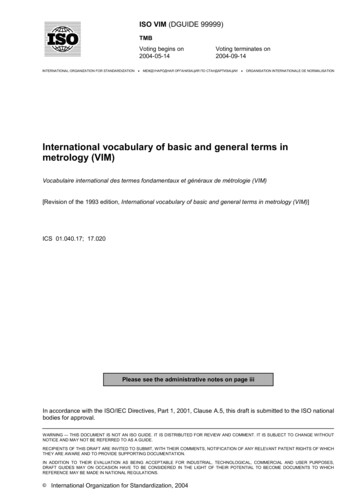
Transcription
ISO VIM (DGUIDE 99999)TMBVoting begins on2004-05-14INTERNATIONAL ORGANIZATION FOR STANDARDIZATION Voting terminates on2004-09-14МЕЖДУНАРОДНАЯ ОРГАНИЗАЦИЯ ПО СТАНДАРТИЗАЦИИ ORGANISATION INTERNATIONALE DE NORMALISATIONInternational vocabulary of basic and general terms inmetrology (VIM)Vocabulaire international des termes fondamentaux et généraux de métrologie (VIM)[Revision of the 1993 edition, International vocabulary of basic and general terms in metrology (VIM)]ICS 01.040.17; 17.020Please see the administrative notes on page iiiIn accordance with the ISO/IEC Directives, Part 1, 2001, Clause A.5, this draft is submitted to the ISO nationalbodies for approval.WARNING — THIS DOCUMENT IS NOT AN ISO GUIDE. IT IS DISTRIBUTED FOR REVIEW AND COMMENT. IT IS SUBJECT TO CHANGE WITHOUTNOTICE AND MAY NOT BE REFERRED TO AS A GUIDE.RECIPIENTS OF THIS DRAFT ARE INVITED TO SUBMIT, WITH THEIR COMMENTS, NOTIFICATION OF ANY RELEVANT PATENT RIGHTS OF WHICHTHEY ARE AWARE AND TO PROVIDE SUPPORTING DOCUMENTATION.IN ADDITION TO THEIR EVALUATION AS BEING ACCEPTABLE FOR INDUSTRIAL, TECHNOLOGICAL, COMMERCIAL AND USER PURPOSES,DRAFT GUIDES MAY ON OCCASION HAVE TO BE CONSIDERED IN THE LIGHT OF THEIR POTENTIAL TO BECOME DOCUMENTS TO WHICHREFERENCE MAY BE MADE IN NATIONAL REGULATIONS. International Organization for Standardization, 2004
ISO VIM (DGUIDE 99999)PDF disclaimerThis PDF file may contain embedded typefaces. In accordance with Adobe's licensing policy, this file may be printed or viewed butshall not be edited unless the typefaces which are embedded are licensed to and installed on the computer performing the editing. Indownloading this file, parties accept therein the responsibility of not infringing Adobe's licensing policy. The ISO Central Secretariataccepts no liability in this area.Adobe is a trademark of Adobe Systems Incorporated.Details of the software products used to create this PDF file can be found in the General Info relative to the file; the PDF-creationparameters were optimized for printing. Every care has been taken to ensure that the file is suitable for use by ISO member bodies. Inthe unlikely event that a problem relating to it is found, please inform the Central Secretariat at the address given below.Copyright noticeThis ISO document is a Draft Guide and is copyright-protected by ISO. Except as permitted under theapplicable laws of the user's country, neither this ISO draft nor any extract from it may be reproduced,stored in a retrieval system or transmitted in any form or by any means, electronic, photocopying, recordingor otherwise, without prior written permission being secured.Requests for permission to reproduce should be addressed to either ISO at the address below or ISO'smember body in the country of the requester.ISO copyright officeCase postale 56 CH-1211 Geneva 20Tel. 41 22 749 01 11Fax 41 22 749 09 47E-mail copyright@iso.orgWeb www.iso.orgReproduction may be subject to royalty payments or a licensing agreement.Violators may be prosecuted.ii ISO 2004 – All rights reserved
ISO VIM (DGUIDE 99999)For convenience in the management of the enquiry ballot, this draft is submitted under the referenceISO DGUIDE 99999. On publication the reference ISO DGUIDE 99999 will be discarded.In accordance with the provisions of Council Resolution 15/1993 this document is circulated in the Englishlanguage only.Conformément aux dispositions de la Résolution du Conseil 15/1993, ce document est distribué en versionanglaise seulement.To expedite distribution, this document is circulated as received from the committee secretariat. ISO CentralSecretariat work of editing and text composition will be undertaken at publication stage.Pour accélérer la distribution, le présent document est distribué tel qu'il est parvenu du secrétariat du comité.Le travail de rédaction et de composition de texte sera effectué au Secrétariat central de l'ISO au stade depublication. ISO 2004 — All rights reservediii
Draft April 2004International Vocabulary of Basic and General Terms inMetrology (VIM)3rd EditionCONTENTSForeword .21 Quantities and unit .42 Measurement . 133 Devices for measurements . 264 Characteristics of measuring systems .305 Measurement standards, etalons 36Annex A: Concepts used in the classical approach (CA) 43to measurementInformative Annex: Diagram concepts .47Bibliography . 48List of acronyms .49Alphabetic index .501
Draft April 2004FOREWORDThe evolution of the treatment of metrological uncertainty from a Classical Approach(CA) to an Uncertainty Approach (UA) necessitated reconsideration of the relateddefinitions in the 2nd edition (1993) of the VIM . The CA took it for granted that ameasurand can ultimately be described by a single true value, but that instrumentsand measurements do not yield this value due to additive “errors”, systematic andrandom. These errors had to be treated differently in “error propagation” and it wasassumed that they may always be distinguished. The notions of “randomuncertainty” and “systematic uncertainty” were introduced without well-foundedmethods of combination and interpretation. Then, instead of random and systematicuncertainties, the unifying concept of “uncertainty” in measurement was introduced,an approach acknowledged by BIPM Recommendation INC-1 (1980), on the basis ofwhich a detailed Guide to the Expression of Uncertainty in Measurement (GUM)(1993, corrected 1995) was developed.In this operational approach to the evaluation of measurement uncertainties there isa shift of perception such that the notion of error no longer plays a role. As aconsequence, there is finally only one uncertainty of measurement, ensuing fromvarious components. It characterizes the extent to which the unknown value of themeasurand is known after measurement, taking account of the given informationfrom the measurement. The concepts and terms presented in Chapters 1-5 of this3rd edition of the VIM reflect this UA. Note that it is beyond the scope of thisVocabulary to provide details for several of the concepts applying to the UA; for suchdetails the interested reader is requested to consult the GUM.There are certain concepts in the 2nd edition of the VIM that apply mostly to the CA,but also reflect some aspects of the UA. These concepts are avoided in the GUM,but are nonetheless considered to be of sufficient importance and common usage tobe included in this Vocabulary. They are presented in Annex A, but in such a way asto be consistent with the CA. Some additional terms pertaining to the CA are alsoincluded in Annex A.A number of concepts which figured in the 2nd edition of the VIM no longer appear inthis 3rd edition. These are concepts which can probably no longer be considered asbasic or general. Some new concepts reflecting the evolution of metrology havebeen introduced, in particular concepts related to measurement uncertainty ormeasurement traceability. Also, the various aspects of measurements in chemistryas well as in physics were considered when establishing this 3rd edition. As a result, anumber of examples covering the fields of measurements in chemistry and inlaboratory medicine have been added.A few definitions in this draft are marked “preliminary definition” for they are still understudy by JCGM-WG2. Concepts figuring in both the 2nd and 3rd editions have adouble reference number; the 3rd edition reference number in bold font and, inparenthesis and in light font, the earlier reference from the 2nd edition.The definitions proposed in this 3rd edition comply as far as possible with the rules tobe applied in terminology work, as outlined in standards ISO 704, ISO 1087-1, andISO 10241. In particular, the substitution principle should apply; it is possible in every2
Draft April 2004definition to replace any term defined elsewhere in the VIM by its definition withoutintroducing contradiction or circularity. Such terms are indicated in bold font in thedefinitions and notes.To facilitate the understanding of the different relations between the various conceptsgiven here, concept diagrams have been introduced in this 3rd edition. They aregiven in an Informative Annex.3
Draft April 2004Chapter 1:QUANTITIES AND UNITS1.1(1.1)quantityproperty of a phenomenon, body, or substance, to which a magnitude can be assignedNOTES1 The concept ‘quantity’ can be subdivided in two levels, general concept and individualconcept.EXAMPLESGeneral concept (name and symbol)quantity, QIndividual concept (name and symbol)length, lradius, rwavelength, Oenergy,kinetic energy, TEheat, Qelectric charge, Qelectric resistance, Ramount-of-substance concentrationof entity B, cBnumber concentration of entity B,CBRockwell C hardness, HRCradius of circle A, rA or r(A)wavelength of the sodium D radiation, OD or O(D; Na)kinetic energy of particle i in a given system, Tiheat of vaporisation of sample i of water, Qielectric charge of the proton, eelectric resistance of resistor i in a given circuit, Riamount-of-substance concentrationof ethanol in wine sample i, ci(C2H5OH)number concentration of erythrocytes in blood samplei, C(Erys; Bi)Rockwell C hardness of steel sample i, HRC(i)2Symbols for quantities are given in the International Standard ISO 31:1992, Quantities andunits.3In laboratory medicine, where lists of individual quantities are presented, each designation isconventionally given in the exhaustive and unambiguous IUPAC/IFCC format “System Component; kind-of-quantity”, where 'System' is the object under consideration, mostly havinga component of special interest, and 'kind-of-quantity' (or 'kind-of-property' if nominalproperties are included) is a label for general concepts such as ‘length’, ‘diameter’, and‘amount-of-substance concentration’. An example of an individual concept under ‘quantity’could be 'Plasma (Blood) Sodium ion; amount-of-substance concentration equal to 143mmol/l in a given person at a given time’.4A vector or a tensor can also be a quantity if all its components are quantities.1.2(Note 2 to 1.1)quantities of the same kindquantities that can be placed in order of magnitude relative to one anotherNOTES1 Quantities of the same kind within a given system of quantities have the same dimension.2The subdivision of quantities into quantities of the same kind is to some extent arbitrary. Forexample, moment of force and energy are, by convention, not regarded as being of the samekind, although they have the same dimension, nor are heat capacity and entropy.EXAMPLES4
Draft April 2004a) All lengths, such as diameters, circumferences and wavelengths, are generally considered asquantities of the same kind.b) All energies, such as work, heat, kinetic energy and potential energy, are generallyconsidered as quantities of the same kind.1.3(1.2)system of quantitiesset of quantities together with a set of non-contradictory equations relating those quantitiesNOTEOrdinal quantities, such as Rockwell C hardness, are usually not considered to be part of asystem of quantities because they are related to other quantities through empirical relationsonly.1.4International System of QuantitiesISQsystem of quantities, together with the equations relating the quantities, on which the SI isbasedNOTEAt present the ISQ is published in the International Standard ISO 31:1992, Quantitiesand units.1.5(1.3)base quantityquantity, chosen by convention, used in a system of quantities to define other quantitiesNOTES1 There exist no equations relating the base quantities of a system of quantities.2“Number of entities” can be regarded as a base quantity in any system of quantities.EXAMPLEThe base quantities corresponding to the base units of the International System of Units(SI) are given in the note to 1.16.1.6(1.4)derived quantityquantity, in a system of quantities, defined as a function of base quantitiesEXAMPLEIn a system of quantities having the base quantities length and mass, mass density is aderived quantity defined as the quotient of mass and volume (length to the third power).5
Draft April 20041.7(1.5)quantity dimensiondimension of a quantitydimensiondependence of a given quantity on the base quantities of a system of quantities,represented by the product of powers of factors corresponding to the base quantitiesNOTES1 The conventional symbolic representation of the dimension of a base quantity is a singleupper case letter in roman (upright) sans-serif type. The conventional symbolic representationof the dimension of a derived quantity is the product of powers of the dimensions of the basequantities according to the definition of the derived quantity.2Quantities having the same dimension are not necessarily quantities of the same kind.3In deriving the dimension of a quantity, no account is taken of any numerical factor, nor of itsscalar, vector or tensor character.4The dimension of a base quantity is generally referred to as ‘base dimension’, and similarly fora ‘derived dimension’.EXAMPLESa) In the ISQ, where L, M and T denote the dimensions of the base quantities length, mass, andtime, the dimension of force is LMT –2.b) In the same system of quantities ML–3 is the dimension of mass concentration and also ofvolumic mass (mass density).1.8(1.6)quantity of dimension onedimensionless quantityquantity for which all the exponents of the factors corresponding to the base quantities in therepresentation of its dimension are zeroNOTES1The values of quantities of dimension one are simply numbers.2The term ‘dimensionless quantity’ is for historical reasons commonly used. It stems from thefact that all exponents are zero in the symbolic representation of the dimension for suchquantities. However, the term ‘quantity of dimension one’ reflects the convention in which thesymbolic representation of the dimension for such quantities is the symbol 1 (see ISO 310
This ISO document is a Draft Guide and is copyright-protected by ISO. Except as permitted under the applicable laws of the user's country, neither this ISO draft nor any extract from it may be reproduced, stored in a retrieval system or transmitted in any form or by any means, electronic, photocopying, recording or otherwise, without prior written permission being secured. Requests for .

